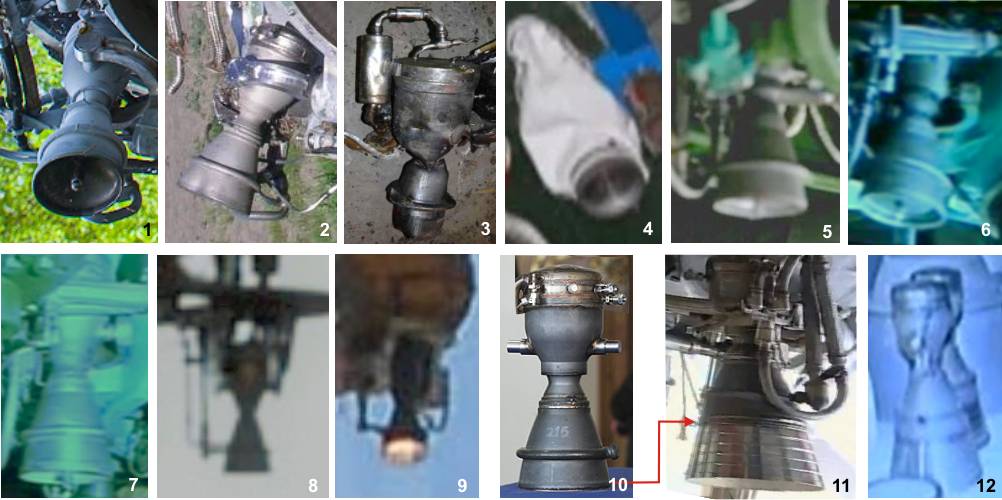|
The steering engines of the Soviet R-27 SLBM
are the only available engines with low thrust in North Korea and Iran. They
are used for various purposes, partially modified, in carrier rockets and
missiles:
|
Rocket
|
Stage
|
Origin
|
Combustors
|
Fig.
|
|
Paektusan-1
|
2.
|
not a 4D10 steering engine
|
4 (pressure-fed mode ?)
|
|
|
Paektusan-2/Safir IRILV
|
4D10 main engine with nozzle
extension
|
2 with own turbopump
|
10,11 |
|
Unha-1/Simorgh IRILV
|
4D10 main engine with nozzle
extension
|
4 with own turbopumps (2)
|
|
|
Unha-2 & Unha-3
|
not a 4D10 steering
engine |
4
(small thruster) |
|
|
HS-14
|
4D10 main engine with nozzle
extension
|
2 with own turbopump
|
|
|
Unha-3
|
3.
|
4D10 main engine with nozzle
extension
|
2 with own turbopump
|
12 |
|
|
|
Unha-2 & Unha-3
|
1.
|
not a 4D10 steering engine
|
4 (pressure-fed mode ?)
|
3,4 |
|
HS-12 & HS-14
|
4D10 steering engine
|
4
|
8,9 |
|
HS-10
|
4D10 steering engine
|
2 with own turbopump
|
6,7 |
|
HS-13
|
4D10 steering engine
|
4 with own turbopums (2)
|
5 |
|

|
Fig. 1 to 2 =
R-27 SLBM
Fig. 3 to 4 =
Unha-2 and -3 (first st.)
(not a 4D10 steerung engine !)
Fig. 5
= HS-13 missile
Fig. 6 to 7 =
HS-10 missile
Fig. 8 to 9 =
HS-12 and HS-14 missile
Fig. 10 to 11 = Safir IRILV
(second st.)
Fig. 12
= Unha-3 (third st.)
|
1. Steering engines in pressure-fed
mode for carrier rockets and missiles
Four steering engines,
used for the first stage of the North Korean Unha-2 and Unha-3 are not
of R-27 SLBM origin. They are homemade, smaller and working in pressure-fed
mode The fuel is supplied from additional tanks (debris captured). As control
engines for the second (Scud) stage of the Paektusan-1 the same engines worked
probably in an other mode. For the second stage of the Unha-2 and Unha-3 are
additional to the main engine uses small pressure-fed thruster.
2. Steering engines without
own turbpump for missiles
The four steering engines of the
H-12 and HS-14 missiles are coupled with the turbopump of the main engine
"Pektusan" (RD-250). Probably, the engines were also used for the second (Scud)
stage of the Paektusan-1 as control engines.
.3.
Steering engines with own turbopump for one-stage missiles
In unchanged version, the combination
of main engine/steering engines of the R-27 SLBM (with the main engine 4D10)
by North Korea is taken over for the HS-10 missile. North Korea is trying
to double the engine system in the North Korean HS-13 ICBM. So far, however,
no test of the rocket is known, especially since there are obviously great
difficulties, to qualify the simplier HS-10 system reliable.
4. Main engine for carrier rockets (2. or 3. stage)
It is believed that the propulsion
of the second stage of the Iranian Safir IRILV was built on base the R-27
SLBM technology and comes secondary from North Korea. In fact, there are similarities
between the R-27 and the Safir upper stage propulsion. The nature of the turbopump
and its placement into the tank and the attachment of the two small engines
on the outside of highly curved bulk are striking. The shape of the vernier
engines of the R-27 are very similar to the Safir IRILV, but they have only
a thrust of about 30 kN with low specific impulse.
Presumably, North Korea has acquired the technology from the R-27. The used
two small Soviet steering engines has been upgraded in its performance. This
also applies to the turbopump of the R-27 Verniers and their arrangement.
This turbopump is located within the tank as in the R-27, however in the centre.
North Korea has probably the changed technology also used in its second stage
for the Paektusan-2 and Unha-1. The Paektusan-2 and Unha-1 were tested, but
later not more of interest and are now the Iranian Safir IRILV and Simorgh
IRILV. North Korea was then focused on the development of the Unha-2 and so
on.
|